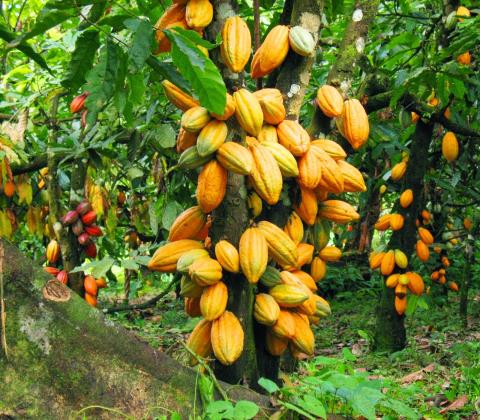Product image
Image

Texte du corps du produit
The cocoa tree is a tropical species native to Mexico, domesticated around 3,000 years ago, most likely initially for the preparation of a fermented drink, therefore alcoholic1. It grows naturally in the basin of the Orinoco and the Amazon at low altitude, at the foot of the Andes Cordillera on low altitude hills (between 200 and 400 m), in the rain forests in the shade of the canopy formed by higher vegetation.
It is a tree that measures 10 to 15 meters high, generally pruned to 6 or 8 meters, cauliflorous and evergreen. It flowers from 3 years and gives flowers, fruits and leaves throughout the year. It reaches its full yield 6 to 7 years after planting and lives up to 40 years2. Its flowers measure about one centimeter and only one in about 500 of them gives fruit. The tree can produce up to 100,000 white or slightly pink flowers annually. They appear all year round on bulges in the wood of the tree, called floral pads. Consequently, flowers and fruit are found on the tree at the same time3,4.
Its fruits, the "pods", are large elongated berries resembling a small American football. Each pod can weigh up to 400 g and is 15 to 20 cm long. They have the particularity of growing both on the main branches but also directly on the trunk of the tree4,5. Their characteristics vary greatly from one population to another, but also within the same population. Forastero immature pods are generally green or pale green and then turn yellow when ripe. For Trinitario and Criollo, immature pods have different intensities of red and, when ripe, orange. The ripening of the fruits lasts, depending on the genotypes, from 5 to 7 months. On average, a tree produces around 150 pods per year, which gives almost 6 kg of cocoa6.
It is a tree that measures 10 to 15 meters high, generally pruned to 6 or 8 meters, cauliflorous and evergreen. It flowers from 3 years and gives flowers, fruits and leaves throughout the year. It reaches its full yield 6 to 7 years after planting and lives up to 40 years2. Its flowers measure about one centimeter and only one in about 500 of them gives fruit. The tree can produce up to 100,000 white or slightly pink flowers annually. They appear all year round on bulges in the wood of the tree, called floral pads. Consequently, flowers and fruit are found on the tree at the same time3,4.
Its fruits, the "pods", are large elongated berries resembling a small American football. Each pod can weigh up to 400 g and is 15 to 20 cm long. They have the particularity of growing both on the main branches but also directly on the trunk of the tree4,5. Their characteristics vary greatly from one population to another, but also within the same population. Forastero immature pods are generally green or pale green and then turn yellow when ripe. For Trinitario and Criollo, immature pods have different intensities of red and, when ripe, orange. The ripening of the fruits lasts, depending on the genotypes, from 5 to 7 months. On average, a tree produces around 150 pods per year, which gives almost 6 kg of cocoa6.
Association des Agriculteurs du CONGO
- http://www.commerce.gouv.cg/aac
- aac@commerce.gouv.cg
- Brazzaville, République Congo
- 066666666